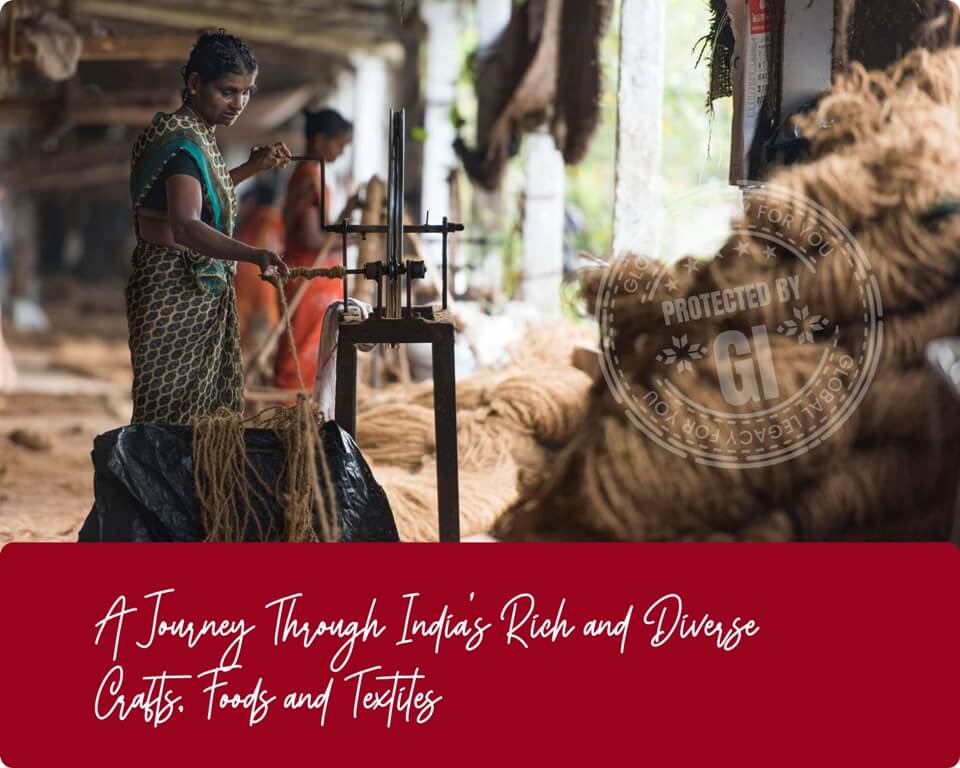
The Story Behind the Label: Uncovering the Origins of India’s GI Products.
India is a land of diversity, where every state and region has a unique culture, tradition, and heritage. This diversity is reflected in the various Geographical Indication (GI) products of India, which are products that are linked to a specific geographic region and have unique qualities that are derived from that region's traditional knowledge and skills.
The history of GI products in India can be traced back to ancient times, when the country was known for its rich and diverse products. These products were not recognized as unique to a specific region, and anyone could produce and sell them. However, this changed in the 1990s when India introduced the Geographical Indications of Goods (Registration and Protection) Act, which provided legal protection to these products and recognized their unique origin and qualities.
The GI system has played a crucial role in promoting sustainable development in India. By recognizing and protecting traditional knowledge and local resources, the system has empowered local communities and encouraged them to preserve their cultural heritage. In this blog, we will explore some case studies and best practices of leveraging Indian Geographical Indications for sustainable development.
The Story Behind the Label
The story behind the label of India's GI products is one of rich history, deep-rooted traditions, and meticulous craftsmanship. Each product is the result of centuries of knowledge and skill passed down through generations, and the label is a testament to the authenticity and quality of these products.
The history of GI products in India dates back to ancient times when different regions specialized in specific crafts and products. However, it was not until the 1990s that the country recognized the importance of protecting these products and introduced the Geographical Indications of Goods (Registration and Protection) Act. This act provided legal protection to the unique products of India and recognized their origin and qualities, thereby providing a platform for artisans and producers to showcase their products to the world.
Today, India has over 360 registered GI products, ranging from handicrafts and textiles to agricultural and food products. Each of these products has a unique story behind its label, which highlights the history, tradition, and cultural significance of that region and contribute significantly to the country's economy.
Uncovering the Origins of India's GI Products
Handicrafts and Textiles
India is known for its exquisite handicrafts and textiles, which are crafted using traditional techniques and designs that are unique to specific regions. The label of these products is a testament to the craftsmanship and quality of the artisans who produce them.
For example, the Channapatna toys from Karnataka are made using lacquer woodwork and are characterized by their bright colors and intricate designs. The label of these toys represents the rich cultural heritage of Karnataka and the skill and expertise of the artisans who produce them.
Similarly,Kalamkari Textiles from Andhra Pradesh that are made using hand-painted or block-printed designs on cotton or silk fabric. The designs are inspired by mythological stories and are a symbol of the rich cultural heritage of Andhra Pradesh.
The Bhujodi Shawls from Gujarat are another lesser-known example of shawls made using a special type of wool found in the Kutch region of Gujarat. They are recognized by their unique designs and bright colors, and are known for their softness and warmth.
Agricultural Products
India is an agricultural country, and its diverse climate and soil conditions have led to the production of some of the world's finest agricultural products. The label of these products is a testament to their unique origin and quality. For example, the Malabar Pepper from Kerala are known for its strong aroma and pungent flavor and considered to be one of the finest varieties of pepper in the world. The Coorg Arabica Coffee from Karnataka known for its mild and mellow flavor. It is grown at an altitude of 3,500 to 5,500 feet above sea level, and the unique climate and soil conditions give it its distinctive taste.
Food Products
Indian cuisine is known for its rich and diverse flavors, and the country has several GI food products that are unique to specific regions. The label of these products represents the authenticity and quality of the ingredients used in their production.
For example, Basmati rice from Punjab is characterized by its long grains and fragrant aroma. The label of this rice represents the rich cultural heritage of Punjab and the meticulous farming techniques used to produce this product.
Similarly, Peda from Uttar Pradesh is a sweet made using condensed milk and sugar. The label of this product represents the unique origin and quality of the ingredients used in its production. Conclusion.
India's GI products are a testament to the country's rich history, cultural diversity, and traditions. The story behind the label of these products is one of meticulous craftsmanship, deep-rooted traditions, and unique origin. The label represents the authenticity and quality of these products and serves as a symbol of the cultural heritage.
Leave A Comment
Your email address will not be published. Required fields are marked *

 USD
USD INR - ₹
INR - ₹
 CAD - Can$
CAD - Can$
 EUR - €
EUR - €
 GBP - £
GBP - £
 SGD - S$
SGD - S$
 AUD - A$
AUD - A$
 MYR - (RM)
MYR - (RM)

0 Comment